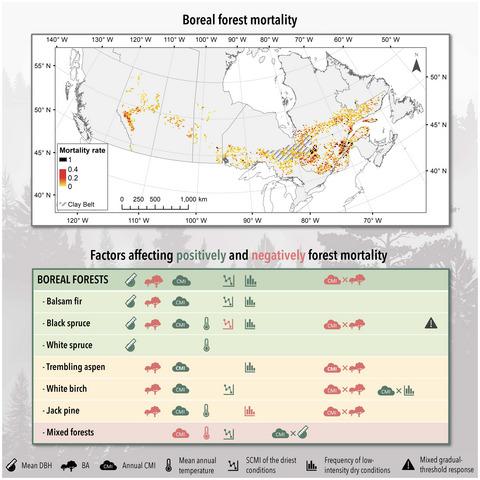当前位置:
X-MOL 学术
›
Glob. Change Biol.
›
论文详情
Our official English website, www.x-mol.net, welcomes your
feedback! (Note: you will need to create a separate account there.)
Sequential droughts: A silent trigger of boreal forest mortality
Global Change Biology ( IF 10.8 ) Pub Date : 2021-10-04 , DOI: 10.1111/gcb.15913 Martina Sánchez-Pinillos 1, 2 , Loïc D'Orangeville 2 , Yan Boulanger 3 , Phil Comeau 4 , Jiejie Wang 2 , Anthony R Taylor 2, 5 , Daniel Kneeshaw 1
Global Change Biology ( IF 10.8 ) Pub Date : 2021-10-04 , DOI: 10.1111/gcb.15913 Martina Sánchez-Pinillos 1, 2 , Loïc D'Orangeville 2 , Yan Boulanger 3 , Phil Comeau 4 , Jiejie Wang 2 , Anthony R Taylor 2, 5 , Daniel Kneeshaw 1
Affiliation

|
Despite great concern for drought-driven forest mortality, the effects of frequent low-intensity droughts have been largely overlooked in the boreal forest because of their negligible impacts over the short term. In this study, we used data from 6876 permanent plots distributed across most of the Canadian boreal zone to assess the effects of repeated low-intensity droughts on forest mortality. Specifically, we compared the relative impact of sequential years under low-intensity dry conditions with the effects of variables related to the intensity of dry conditions, stand characteristics, and local climate. Then, we searched for thresholds in forest mortality as a function of the number of years between two forest surveys affected by dry conditions of any intensity. Our results showed that, in general, frequent low-intensity dry conditions had stronger effects on forest mortality than the intensity of the driest conditions in the plot. Frequent low-intensity dry conditions acted as an inciting factor of forest mortality exacerbated by stand characteristics and environmental conditions. Overall, the mortality of forests dominated by shade-tolerant conifers was significantly and positively related to frequent low-intensity dry conditions, supporting, in some cases, the existence of thresholds delimiting contrasting responses to drought. In mixtures with broadleaf species, however, sequential dry conditions had a negligible impact. The effects of frequent dry conditions on shade-intolerant forests mainly depended on local climate, inciting or mitigating the mortality of forests located in wet places and dominated by broadleaf species or jack pine, respectively. Our results highlight the importance of assessing not only climate-driven extreme events but also repeated disturbances of low intensity. In the long term, the smooth response of forests to dry conditions might abruptly change leading to disproportional mortality triggered by accumulated stress conditions. Forest and wildlife managers should consider the cumulative effects of climate change on mortality to avoid shortfalls in timber and habitat.
中文翻译:

连续干旱:北方森林死亡的无声触发
尽管对干旱导致的森林死亡率非常关注,但频繁发生的低强度干旱在北方森林中的影响在很大程度上被忽视了,因为它们在短期内的影响可以忽略不计。在这项研究中,我们使用分布在加拿大北方大部分地区的 6876 个永久性地块的数据来评估重复的低强度干旱对森林死亡率的影响。具体而言,我们将低强度干旱条件下连续年份的相对影响与与干旱条件强度、林分特征和当地气候相关的变量的影响进行了比较。然后,我们搜索了作为受任何强度干旱条件影响的两次森林调查之间年数的函数的森林死亡率阈值。我们的结果表明,总的来说,与样地中最干燥条件的强度相比,频繁的低强度干旱条件对森林死亡率的影响更大。频繁的低强度干旱条件是林分特征和环境条件加剧的森林死亡率的诱因。总体而言,以耐阴针叶树为主的森林的死亡率与频繁的低强度干旱条件显着正相关,在某些情况下,支持了界定对干旱的对比反应的阈值的存在。然而,在与阔叶树种的混合物中,连续干燥条件的影响可以忽略不计。频繁的干旱条件对不耐阴林的影响主要取决于当地气候,刺激或减轻位于湿地并以阔叶树或针叶松为主的森林的死亡,分别。我们的结果强调了不仅评估气候驱动的极端事件而且评估低强度重复干扰的重要性。从长远来看,森林对干旱条件的平稳反应可能会突然改变,从而导致累积压力条件引发的不成比例的死亡率。森林和野生动物管理者应考虑气候变化对死亡率的累积影响,以避免木材和栖息地短缺。
更新日期:2021-12-13
中文翻译:

连续干旱:北方森林死亡的无声触发
尽管对干旱导致的森林死亡率非常关注,但频繁发生的低强度干旱在北方森林中的影响在很大程度上被忽视了,因为它们在短期内的影响可以忽略不计。在这项研究中,我们使用分布在加拿大北方大部分地区的 6876 个永久性地块的数据来评估重复的低强度干旱对森林死亡率的影响。具体而言,我们将低强度干旱条件下连续年份的相对影响与与干旱条件强度、林分特征和当地气候相关的变量的影响进行了比较。然后,我们搜索了作为受任何强度干旱条件影响的两次森林调查之间年数的函数的森林死亡率阈值。我们的结果表明,总的来说,与样地中最干燥条件的强度相比,频繁的低强度干旱条件对森林死亡率的影响更大。频繁的低强度干旱条件是林分特征和环境条件加剧的森林死亡率的诱因。总体而言,以耐阴针叶树为主的森林的死亡率与频繁的低强度干旱条件显着正相关,在某些情况下,支持了界定对干旱的对比反应的阈值的存在。然而,在与阔叶树种的混合物中,连续干燥条件的影响可以忽略不计。频繁的干旱条件对不耐阴林的影响主要取决于当地气候,刺激或减轻位于湿地并以阔叶树或针叶松为主的森林的死亡,分别。我们的结果强调了不仅评估气候驱动的极端事件而且评估低强度重复干扰的重要性。从长远来看,森林对干旱条件的平稳反应可能会突然改变,从而导致累积压力条件引发的不成比例的死亡率。森林和野生动物管理者应考虑气候变化对死亡率的累积影响,以避免木材和栖息地短缺。









































 京公网安备 11010802027423号
京公网安备 11010802027423号